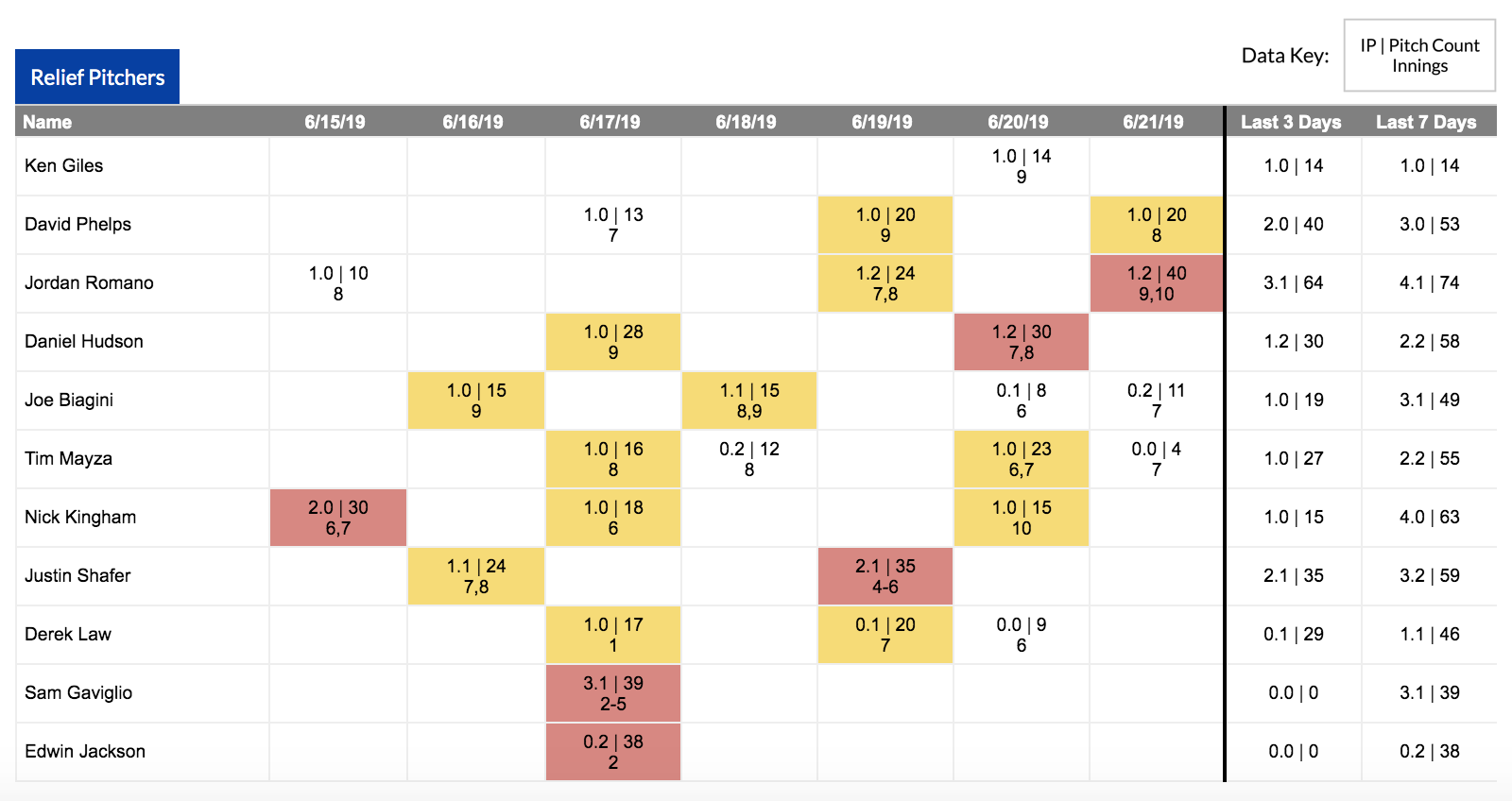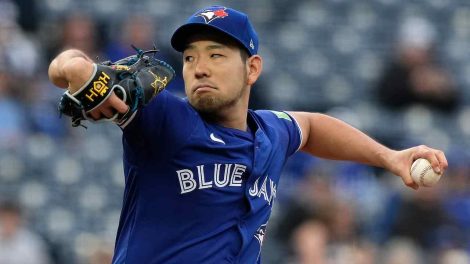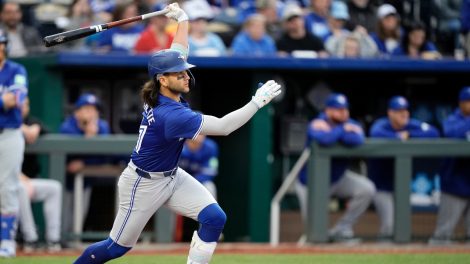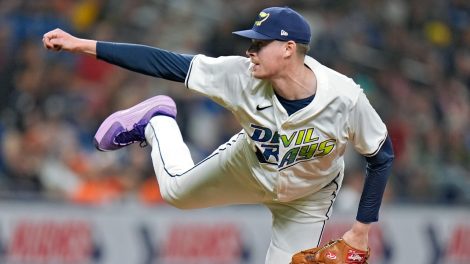BOSTON — Having spent 17 years as a minor-league manager, Charlie Montoyo’s well-familiarized with navigating difficult circumstances. He’s dealt with starters being scratched last minute, weather wreaking havoc on his team’s schedule and major-league call-ups leaving his roster in a state of perpetual flux.
It’s supposed to be different now that he’s in the majors. A big league manager should, hypothetically, have a full rotation of starting pitchers who can carry a considerable workload once every five days. And in times of strife, you’re meant to have organizational options at your disposal, calling upon triple-A or even double-A players to fill ranks and make spot starts, forcing some minor-league manager to sort out the consequences to his roster.
Montoyo doesn’t enjoy that luxury. His organization is embarrassingly thin on capable starting pitchers. Toronto has four on its big-league roster, five on its injured list, and none in the minors that it currently feels confident summoning to make an MLB start.
Sean Reid-Foley has been maddeningly inconsistent and spotty with his command, walking four batters or more in three of his last five outings. Thomas Pannone is still in the process of getting stretched out after spending most of his season in Toronto’s bullpen. Julian Merryweather will pitch his first game in more than 21 months Monday, making his return from Tommy John surgery. And T.J. Zeuch made only his third appearance of the season Saturday with triple-A Buffalo, after he missed more than two months with a lat injury.
That’s how you end up with a situation like Saturday, when the Blue Jays simply chose not to fill an opening in their rotation that they knew was coming for some time. It was a bullpen day, in essence. Or, as Montoyo put it a couple hours before the game: “Today, we’re just trying to cover innings.”
The problem with that is Toronto’s bullpen looked like this:

Montoyo was forced to use four relievers the night prior — Tim Mayza, Joe Biagini, David Phelps, and Jordan Romano. And each of them surrendered at least a run. Romano threw 40 pitches, making him unavailable for Sunday’s game. Mayza made his fourth appearance in five days, rendering him unavailable, as well.
Meanwhile, Biagini and Phelps were firmly within yellow territory on Montoyo’s lineup card, meaning they were available only in dire circumstances, but really ought to have the day off. That left five pitchers with which Montoyo planned to get through a game without a true starter. And let’s take a look at how that worked out.
The starter — Derek Law
1.1 IP, 2 H, 4 R, 4 ER, 2 BB, 0 K
The last two times Law started games for the Blue Jays, it was as an opener for Edwin Jackson, who the club was trying to help through significant struggles by allowing him to begin his outing against the bottom of the order. This time, Law was starting with the goal of going two innings and chewing up six outs. He wound up getting only four.
It started well enough. After a flash shower delayed first pitch by 30 minutes, Law cruised through his first inning, getting three ground balls on 17 pitches. But he issued a leadoff walk in the second, and the next batter, Brock Holt, rocketed a 92-m.p.h. comebacker off Law’s right foot. The big right-hander barely reacted, watching the ball ricochet perfectly to first base for an out. As Blue Jays trainer Jose Ministral walked to the mound to check on him, Law looked at the Toronto staffer like, what are you doing out here?
But clearly something affected him. Law missed with four of his next five pitches, putting a second runner on, before allowing back-to-back, well-struck line drives. Three runs were in. Montoyo was up. And Sam Gaviglio was jogging in from the bullpen.
The long man — Sam Gaviglio
3.2 IP, 6 H, 2 ER, 1 BB, 1 K
What a strange season Gaviglio’s had. After making the Blue Jays out of spring training as a swingman, he went on an absolute tear through mid-May, posting a 1.76 ERA across his first 30.2 innings, all of them in relief. He allowed only 16 hits and four walks in that span, striking out a batter an inning. For as bad as the Blue Jays have been, it’s a wonder how low they might have sunk without Gaviglio throwing up zeroes.
But the regression hit like a tidal wave. Gaviglio allowed runs in nine of his 10 appearances from that point on, pitching to a 9.17 ERA over 17.2 innings. He surrendered 28 hits and 18 earned runs along the way. He went from facing leverage to working mostly in games his team was trailing by three or more, which there have been plenty of.
And there was another on Saturday. Gaviglio inherited Law’s mess with one out in the second and only made it worse. He got a second out quickly, but then walked Mookie Betts and allowed a loud double off the green monster to Andrew Benintendi. Two more scored. And another came around in the third, as Christian Vazquez drove a solo shot off the right field foul pole. It was the 13th home run Gaviglio’s allowed this season.
But Gaviglio gives you innings, and the Blue Jays needed them badly. So, short of his arm falling off, Gaviglio was staying in the game. He allowed plenty more hard contact (eight of the balls put in play against Gaviglio came off bats at over 96-m.p.h.) but did his job. He chewed up 3.2 innings, getting the Blue Jays through five.
[snippet id=4545751]
The bridge — Nick Kingham
2.0 IP, 0 H, 0 ER, 1 BB, 3 K
Above Nick Kingham’s locker in the visitors’ clubhouse at Fenway Park, a blue-and-white nameplate read, “Nick Kinghan.” No one seemed to notice.
What a meat grinder this game can be. Kingham was a consensus top-100 MLB prospect only five years ago, and took a perfect game into the seventh inning of his MLB debut in 2018, three years after Tommy John surgery derailed his top prospect status. But inconsistent performance over the following 12 months led to Kingham hitting waivers, where the pitching-starved Blue Jays snatched him up.
Which brought him to Fenway Park Saturday, where he jogged in from the bullpen, the name on the back of his jersey spelled correctly, to pitch mop-up duty in the bottom of the sixth inning. He worked around a walk to get his three outs, and after Toronto’s offence broke out in the top of the seventh, riding back-to-back homers by Freddy Galvis and Rowdy Tellez to cut Boston’s lead to one, Kingham returned for a second inning in a suddenly tight game.
Only 14 pitches later, he’d gone three up, three down with a pair of strike outs. It was the finest inning a Toronto pitcher had thrown all day. And in the top of the eighth, Teoscar Hernandez singled, advanced to second on a wild pitch, and scored on a Cavan Biggio base hit, completing a five-run Blue Jays rally to tie it. A while later, Biggio crossed the plate himself as the Red Sox walked in a run to put the Blue Jays up by one. Eight pitches later, they walked in another.
Just like that, Kingham was in line for the win. A bullpen day that began with the manager wanting to cover innings suddenly took on a completely different tenor. In a baseball game, just like in a career, things can change awfully quickly.
The set-up guy — Daniel Hudson
1.0 IP, 0 H, 0 ER, 0 BB, 1 K
The Blue Jays are Hudson’s fifth team in the last four seasons, which is less a reflection on his viability as a major-league reliever, and more an indication of how tenuous big-league life can be for pitchers of his ilk. Clubs just don’t value relievers like they used to. Even those who throw 96 m.p.h. like Hudson does.
But since signing with Toronto at the end of spring training — after he was released by the Los Angeles Angels — the 32-year-old has quietly provided a much-needed steady hand, pitching to a 3.03 ERA over 32.2 innings. He’s had his blips, but Hudson’s been dependable more often than not.
And he was again Saturday. Working with a two-run lead, Hudson came in firing darts, mixing 96-m.p.h. fastballs with sweeping, 84-m.p.h. sliders. He got a pair of fly balls and, at the end of an eight-pitch battle with Michael Chavis, a swinging strikeout. As Hudson roared and walked off the mound, the Blue Jays bullpen over his left shoulder began to stir. Ken Giles was getting up.
The closer — Ken Giles
1.0 IP, 1 H, 1 ER, 0 BB, 3 K
It’s truly wild just how good Giles has been this season. He’s allowed runs in only two of his 26 appearances, and so much as a baserunner in only 14. His 15.2 K/9 coming into Saturday was third among MLB relievers, his 0.35 HR/9 was tied for eighth. He’s been one of baseball’s best relievers, and should be a lock to represent Toronto at next month’s all-star game, provided he’s still wearing a Blue Jays uniform by mid-July.
He’s breathing rarefied air. The only other reliever in the history of the game to throw a season of at least 26 innings with an ERA of 1.04 or lower and a K/9 of 15 or higher is Craig Kimbrel, who had a 1.01 ERA with 16.6 K/9 over 62.2 innings in 2012. Giles obviously has many innings to go before he gets close to matching that. But he’s nearly halfway there.
But the thing about having such a lights-out closer is you need tight leads for him to save. The Blue Jays don’t often have those. Entering Saturday’s game, Giles had seen only four save opportunities since the beginning of May, converting them all. Part of that’s due to Giles missing 10 days with elbow inflammation. A bigger part of it is the Blue Jays being 22 games under .500.
So, Giles has often worked in ties, blowouts, or with his team trailing, because the guy has to pitch some time. Saturday, his team’s pitching staff stretched to its absolute limits, was shaping up to be one of them. But then the Blue Jays put up that four spot in the seventh, and three more in the eighth. And then Giles was jogging in for his first save opportunity in two-and-a-half weeks.
He struck out his first batter, Rafael Devers, on six pitches, two of them 98-m.p.h., two of them 99. Mookie Betts was next. He walked and stole second. No matter to Giles. He struck out another. Two out.
He then got a lazy fly ball to shallow left field, which the Blue Jays misplayed into a run-scoring ground-rule double. Lead down to one. All 37,000 around him on their feet. No matter again. Giles reached back and blew 98-m.p.h. past J.D. Martinez for his third strikeout. Ballgame. Giles’ 12th save. Kingham, the winner.
—
It was Montoyo’s plan all along. Get everything he could out of Law, some length from Gaviglio, and a couple innings from Kingham, before letting Hudson and Giles carry the game over the finish line. That it worked out exactly the way he drew it up doesn’t absolve the Blue Jays from placing him in such an unfavourable position in the first place. A major-league team should be able to conjure a fifth starter. Montoyo shouldn’t be forced to piece it together like this, as if he’s back in the minors.
But on a remarkable bullpen day at Fenway Park, the Blue Jays didn’t need a starter at all. They needed only some timely hitting, five relievers, and the plan Montoyo charted. They won, 8-7.
[relatedlinks]









